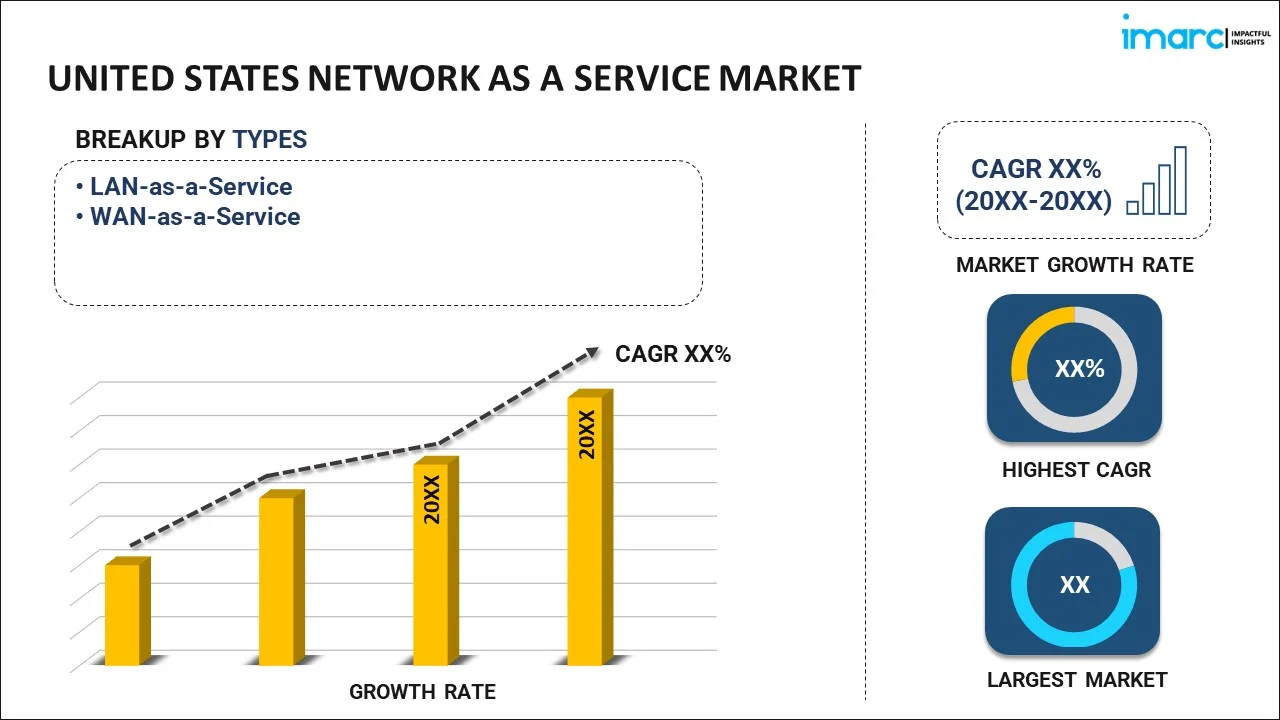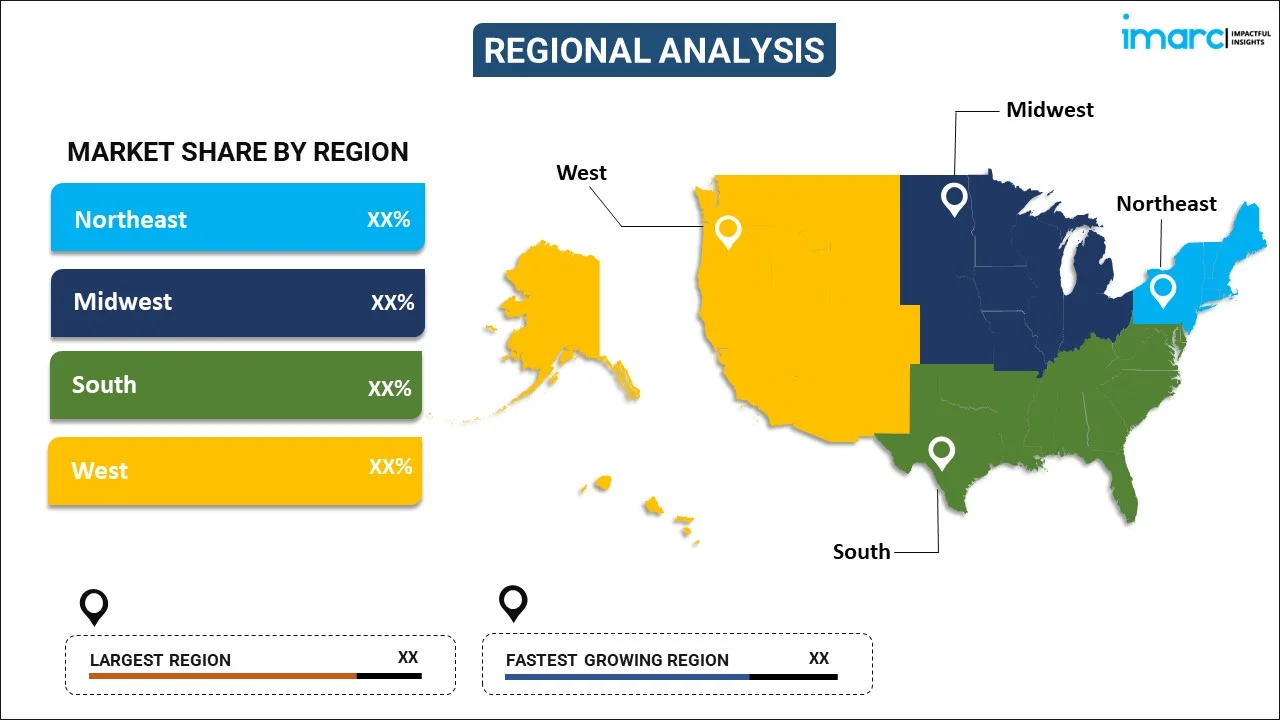
United States Network as a Service Market Report by Type (LAN-as-a-Service, WAN-as-a-Service), Application (Cloud-based Services, Bandwidth on Demand, Integrated Network Security-as-a-Service, Wide Area Network, Virtual Private Network), End Use Industry (Healthcare, BFSI, Retail and E-Commerce, IT and Telecom, Manufacturing, Transportation and Logistics, Public Sector), and Region 2025-2033
Market Overview:
United States network as a service market size reached USD 2.3 Billion in 2024. Looking forward, IMARC Group expects the market to reach USD 26.8 Billion by 2033, exhibiting a growth rate (CAGR) of 31.5% during 2025-2033. The growing cybersecurity concerns among businesses, the integration of artificial intelligence (AI) and machine learning (ML) into network management, and the widespread adoption of blockchain technology in finance, supply chain, and healthcare industries represent some of the key factors driving the market.
|
Report Attribute
|
Key Statistics
|
|---|---|
|
Base Year
|
2024
|
|
Forecast Years
|
2025-2033
|
|
Historical Years
|
2019-2024
|
|
Market Size in 2024
|
USD 2.3 Billion |
|
Market Forecast in 2033
|
USD 26.8 Billion |
| Market Growth Rate 2025-2033 | 31.5% |
Network as a Service (NaaS) is a cloud-based service model that provides organizations with on-demand access to networking resources and capabilities. It can easily scale up or down to accommodate changing network requirements, ensuring flexibility and cost-efficiency. It leverages virtualization technologies to create and manage network resources, making it more adaptable and easier to manage. It offers high availability and redundancy, minimizing downtime and ensuring business continuity. It reduces capital expenditures on hardware and lowers operational costs associated with maintenance and management. It streamlines network provisioning and management processes, improving overall operational efficiency. It can be accessed from anywhere with an internet connection, making it suitable for geographically dispersed organizations. It can connect remote offices and branch locations seamlessly, providing a unified network experience. It enables secure and high-performance connectivity to cloud services, facilitating the adoption of cloud-based applications and infrastructure. It supports the growing network demands of IoT devices by offering scalable and reliable connectivity. It is widely used by managed service providers to deliver networking solutions to their clients.
United States Network as a Service Market Trends:
The growing cybersecurity concerns among businesses in the United States are stimulating the market growth. NaaS providers often incorporate robust security features, including encryption and threat detection, to protect data and network traffic, making it an attractive choice for organizations seeking to enhance their network security. Additionally, several businesses are actively pursuing digital transformation initiatives to remain competitive and meet evolving customer expectations. NaaS aids in offering agile and adaptable networking solutions that can support the integration of new technologies and digital services seamlessly. Apart from this, the country is witnessing the acceptance of hybrid work models. NaaS supports these models by providing secure and flexible connectivity for both on-premises and remote workers. Furthermore, the increasing regulatory requirements related to data privacy and compliance, such as the California Consumer Privacy Act (CCPA) and the Health Insurance Portability and Accountability Act (HIPAA), are encouraging American organizations to ensure the security and integrity of their networks. NaaS providers are aligning their services with these regulations to help clients meet their compliance needs. In line with this, the widespread adoption of blockchain technology in finance, supply chain, and healthcare industries is strengthening the growth of the market. NaaS offers the secure and reliable network infrastructure needed to support blockchain implementations and transactions. In addition, the integration of artificial intelligence (AI) and machine learning (ML) into network management to optimize traffic routing, enhance security, and predict network issues is facilitating the market growth. NaaS providers in the country are incorporating AI and ML capabilities to offer intelligent and predictive networking solutions.
United States Network as a Service Market Segmentation:
IMARC Group provides an analysis of the key trends in each segment of the market, along with forecasts at the country level for 2025-2033. Our report has categorized the market based on type, application, and end use industry.
Type Insights:

- LAN-as-a-Service
- WAN-as-a-Service
The report has provided a detailed breakup and analysis of the market based on the type. This includes LAN-as-a-service and WAN-as-a-service.
Application Insights:
- Cloud-based Services
- Bandwidth on Demand
- Integrated Network Security-as-a-Service
- Wide Area Network
- Virtual Private Network
A detailed breakup and analysis of the market based on the application have also been provided in the report. This includes cloud-based services, bandwidth on demand, integrated network security-as-a-service, wide area network, and virtual private network.
End Use Industry Insights:
- Healthcare
- BFSI
- Retail and E-Commerce
- IT and Telecom
- Manufacturing
- Transportation and Logistics
- Public Sector
The report has provided a detailed breakup and analysis of the market based on the end use industry. This includes healthcare, BFSI, retail and e-commerce, IT and telecom, manufacturing, transportation and logistics, and public sector.
Regional Insights:

- Northeast
- Midwest
- South
- West
The report has also provided a comprehensive analysis of all the major regional markets, which include the Northeast, Midwest, South, and West.
Competitive Landscape:
The market research report has also provided a comprehensive analysis of the competitive landscape. Competitive analysis such as market structure, key player positioning, top winning strategies, competitive dashboard, and company evaluation quadrant has been covered in the report. Also, detailed profiles of all major companies have been provided.
United States Network as a Service Market Report Coverage:
| Report Features | Details |
|---|---|
| Base Year of the Analysis | 2024 |
| Historical Period | 2019-2024 |
| Forecast Period | 2025-2033 |
| Units | Billion USD |
| Scope of the Report | Exploration of Historical Trends and Market Outlook, Industry Catalysts and Challenges, Segment-Wise Historical and Future Market Assessment:
|
| Types Covered | LAN-as-a-Service, WAN-as-a-Service |
| Applications Covered | Cloud-based Services, Bandwidth on Demand, Integrated Network Security-as-a-Service, Wide Area Network, Virtual Private Network |
| End Use Industries Covered | Healthcare, BFSI, Retail and E-Commerce, IT and Telecom, Manufacturing, Transportation and Logistics, Public Sector |
| Regions Covered | Northeast, Midwest, South, West |
| Customization Scope | 10% Free Customization |
| Post-Sale Analyst Support | 10-12 Weeks |
| Delivery Format | PDF and Excel through Email (We can also provide the editable version of the report in PPT/Word format on special request) |
Key Questions Answered in This Report:
- How has the United States network as a service market performed so far and how will it perform in the coming years?
- What has been the impact of COVID-19 on the United States network as a service market?
- What is the breakup of the United States network as a service market on the basis of type?
- What is the breakup of the United States network as a service market on the basis of application?
- What is the breakup of the United States network as a service market on the basis of end use industry?
- What are the various stages in the value chain of the United States network as a service market?
- What are the key driving factors and challenges in the United States network as a service?
- What is the structure of the United States network as a service market and who are the key players?
- What is the degree of competition in the United States network as a service market?
Key Benefits for Stakeholders:
- IMARC’s industry report offers a comprehensive quantitative analysis of various market segments, historical and current market trends, market forecasts, and dynamics of the United States network as a service market from 2019-2033.
- The research report provides the latest information on the market drivers, challenges, and opportunities in the United States network as a service market.
- Porter's five forces analysis assist stakeholders in assessing the impact of new entrants, competitive rivalry, supplier power, buyer power, and the threat of substitution. It helps stakeholders to analyze the level of competition within the United States network as a service industry and its attractiveness.
- Competitive landscape allows stakeholders to understand their competitive environment and provides an insight into the current positions of key players in the market.
Need more help?
- Speak to our experienced analysts for insights on the current market scenarios.
- Include additional segments and countries to customize the report as per your requirement.
- Gain an unparalleled competitive advantage in your domain by understanding how to utilize the report and positively impacting your operations and revenue.
- For further assistance, please connect with our analysts.
 Request Customization
Request Customization
 Speak to an Analyst
Speak to an Analyst
 Request Brochure
Request Brochure
 Inquire Before Buying
Inquire Before Buying




.webp)




.webp)












